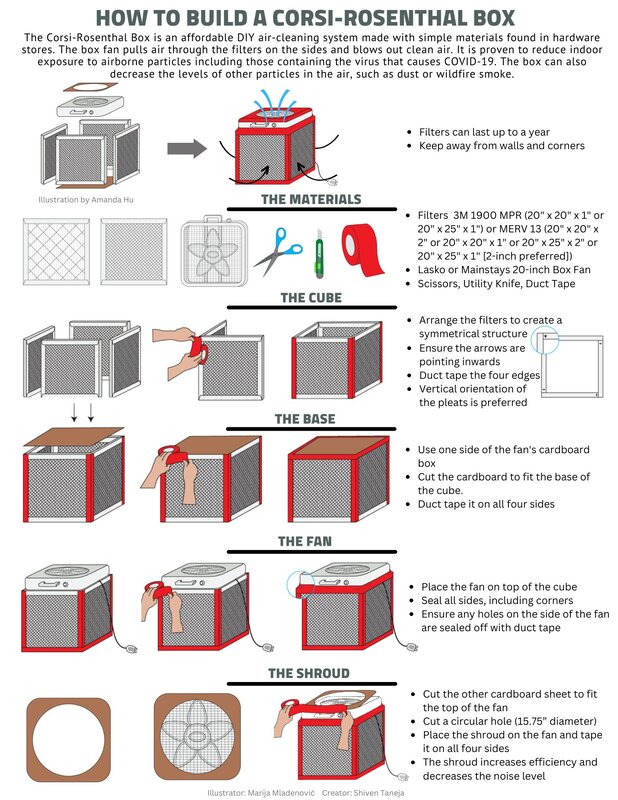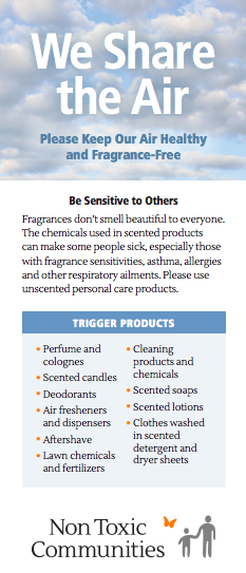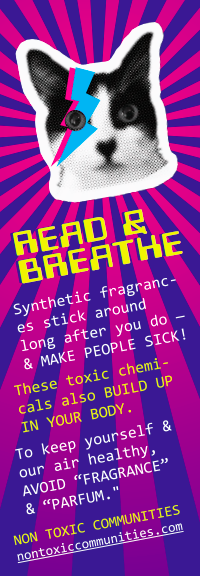Fragrances are an often overlooked source of air pollution. Many employers, schools, doctor’s offices and others are now creating fragrance free policies to address this.
Learn about the "fragrance loophole" from the documentary film, Stink!. This film is a clear and concise explanation of the inadequacies of chemical regulations to protect the public from toxic substances.
Cleaning products can also contribute to indoor air pollution. Many of these products are registered with the EPA as they are considered pesticides.
Grassroots Environmental Education has a program called The Childsafe School. They have compiled a list of safer bio-based products for cleaning.
Pesticides used indoors are another source of toxic exposure in indoor air. A good structural integrated pest management (IPM) program can minimize the use of pesticides by preventing pest problems, and utilizes only the least toxic products when needed.
Beyond Pesticides has a model IPM contract available here. Read more about structural IPM from their website.
Cleaning products can also contribute to indoor air pollution. Many of these products are registered with the EPA as they are considered pesticides.
Grassroots Environmental Education has a program called The Childsafe School. They have compiled a list of safer bio-based products for cleaning.
Pesticides used indoors are another source of toxic exposure in indoor air. A good structural integrated pest management (IPM) program can minimize the use of pesticides by preventing pest problems, and utilizes only the least toxic products when needed.
Beyond Pesticides has a model IPM contract available here. Read more about structural IPM from their website.
COVID is Airborne
Indoor air quality can directly affect the risk of acquiring a viral illness like Covid-19. The SARS-CoV-2 virus is spread mainly by aerosols (tiny particles) from the respiratory tract of an infected person. These aerosols can hang in the air like smoke, and build up in indoor spaces. Using ventilation and filtration can reduce the amount of infectious aerosols in the air and reduce the risk of people becoming ill. Filtration also reduces particles from wildfire smoke and other pollutants. There is no downside to clean air!
HOW COVID SPREADS
HOW TO CLEAN THE AIR
Benefits of improving Indoor air quality
Installing air filters in classrooms has surprisingly large educational benefits
Investing in indoor air quality improvements in schools will reduce COVID transmission and help students learn
Corsi-Rosenthal box filters reduce indoor air concentrations of phthalates and PFAS
Reduced VOCs and SVOCs in indoor environments
A Totally Serious Animation About Indoor Air Quality in Schools
901 Class-ACT: the UK’s trial on the feasibility and effectiveness of air cleaning technologies in schools
Investing in indoor air quality improvements in schools will reduce COVID transmission and help students learn
Corsi-Rosenthal box filters reduce indoor air concentrations of phthalates and PFAS
Reduced VOCs and SVOCs in indoor environments
A Totally Serious Animation About Indoor Air Quality in Schools
901 Class-ACT: the UK’s trial on the feasibility and effectiveness of air cleaning technologies in schools
far uvc light
IAQ Concerns
DIY Filtration Safety & Science
An Evaluation of DIY Air Filtration
Testing the Efficacy of the ‘Corsi-Rosenthal’ Box Fan Filter in an Active Classroom Environment
Efficacy of Do-It-Yourself air filtration units in reducing exposure to simulated respiratory aerosols
Corsi-Rosenthal box filters reduce indoor air concentrations of phthalates and PFAS
Effects of Corsi-Rosenthal boxes on indoor air contaminants: non-targeted analysis using high resolution mass spectrometry
Testing the Efficacy of the ‘Corsi-Rosenthal’ Box Fan Filter in an Active Classroom Environment
Efficacy of Do-It-Yourself air filtration units in reducing exposure to simulated respiratory aerosols
Corsi-Rosenthal box filters reduce indoor air concentrations of phthalates and PFAS
Effects of Corsi-Rosenthal boxes on indoor air contaminants: non-targeted analysis using high resolution mass spectrometry
Graphic shared courtesy of Shiven Taneja
|
Use this free rack card to spread awareness and advocate for cleaner air in your community.
|
Use these kids bookmarks created by Jennie Chamberlain and Kelley King to spread the word.
|
Click on the image to download a press quality PDF.
VISIT THESE WEBSITES TO LEARN MORE
Healthy Buildings website by the Harvard T.H. Chan School of Public Health.
Dr. Anne Steinemann is an internationally recognized expert on pollutant exposures and associated health effects, including topics of indoor air quality, consumer product testing and evaluation, exposure assessment, and healthy homes and communities.
Indoor Air Care Advocates are dedicated to seeing US schools implement engineering controls that are proven to reduce airborne illnesses, decrease absences, and keep kids in school safely.
Corsi-Rosenthal Foundation is a non-profit organization dedicated to improving indoor air quality through education and research for all – especially to benefit children in schools whose air quality could be improved.
Healthy Buildings website by the Harvard T.H. Chan School of Public Health.
Dr. Anne Steinemann is an internationally recognized expert on pollutant exposures and associated health effects, including topics of indoor air quality, consumer product testing and evaluation, exposure assessment, and healthy homes and communities.
Indoor Air Care Advocates are dedicated to seeing US schools implement engineering controls that are proven to reduce airborne illnesses, decrease absences, and keep kids in school safely.
Corsi-Rosenthal Foundation is a non-profit organization dedicated to improving indoor air quality through education and research for all – especially to benefit children in schools whose air quality could be improved.
Loading PurpleAir Widget...




